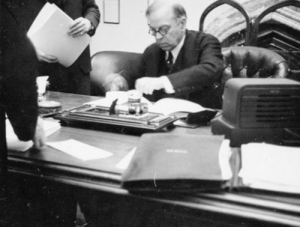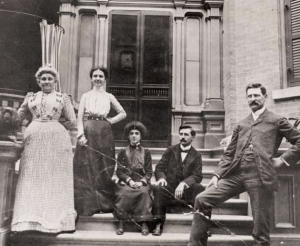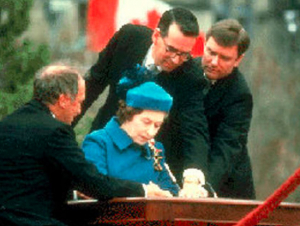Phyllis Turner Ross - Career Woman and Single Mother
The story of John Napier Turner, Canada's 17th Prime Minister, is well known. Less known is the story of his remarkable mother, Phyllis Gregory Turner Ross, a single mother who came to Ottawa in the 1930s looking for work to support her two children... and worked her way up to become the highest-ranking woman in Canada's wartime civil service.
Paul Litt tells the story of Phyllis Gregory Turner Ross, along with a special interview with Phyllis' daughter, Brenda Norris.
British Commonwealth Air Training Plan
17 December 1939
“You must get on with the war, and in order to enable you to do so I now declare No.2 Service Flying Training School [SFTS] open,” said the Governor General, the Earl of Athlone, under bright blue skies at Uplands Airport just outside of Ottawa. With these words, the first intermediate flying school of the British Commonwealth Air Training Plan (BCATP) was open for business. (No. 1 SFTS, located at Camp Borden opened three months later.) Eight Elementary Flying Training Schools (EFTS), located across the country, had already opened earlier that summer to provide basic flying skills to novice flyers.
The opening of No.2 SFTS came none too soon. Across the Atlantic that afternoon of 5 August 1940, the Battle of Britain was raging. With the RAF sorely stretched, trained pilots were desperately needed, both for the battle underway and for the successful future prosecution of the air war against the German Luftwaffe.
The genesis of the BCATP dated back to the mid-1930s when Britain, conscious of the growing Nazi threat, began to rebuild its armed forces, including its air service. In 1936, a Scottish-Canadian in the Royal Air Force (RAF), Group Captain Robert Leckie, wrote a memorandum to Arthur Tedder, then Director of Training at the British Air Ministry, suggesting Canada as an ideal location to train air crews. Canada was safe from enemy attack, and was close to the U.S. industrial heartland which could supply necessary aircraft engines and parts.
Additionally, the Royal Canadian Air Force (RCAF) had a close relationship with its British counterpart. As well, the RAF routinely recruited Canadians for both short-term and permanent positions. Moreover, during the latter years of World War I, flight training schools had been established in Canada by the Royal Flying Corps, the forerunner of the RAF.
When Prime Minister Mackenzie King got wind of the idea, he was conflicted. On the one hand, he was very protective of Canada’s new sovereignty. Following the ratification of the Statute of Westminster in 1931, Canada was no longer subordinate to Great Britain either domestically or internationally. Consequently, he could not support RAF bases in Canada. The Prime Minister was also conscious of how the presence of British bases in Canada might appear to Quebec voters. On the other hand, he thought that if Canada’s contribution to the coming war effort could be largely focused on training air crews in Canada, it might be possible to avoid both large-scale casualties and a repeat of the conscription crisis that had divided the country during the previous war.
Agreement was reached to increase the number of Canadian-trained pilots for the RAF, and steps were taken to develop a common RAF/RCAF flying syllabus among other things. However, Leckie’s concept of using Canada for RAF training bases was put on the backburner until the outbreak of war in September 1939 when Vincent Massey, Canada’s High Commissioner in London, met with his Australian counterpart, Stanley Bruce. Out of this meeting was born the British Commonwealth Air Training Plan. Who came up with idea is unclear as both men took credit for it. Regardless, they made a joint submission to the British authorities. Neville Chamberlain, the British Prime Minister, was enthusiastic, and made a personal appeal to Mackenzie King asking him to give the proposal his very urgent attention. Chamberlain expressed the view that the establishment of training bases in Canada safe from German attack would have a psychological impact on Germany equivalent to that produced by the entry of the United States into the previous war.
While Prime Minister King was initially upset that Massey had exceeded his authority, he quickly warmed to the idea…with conditions. Most importantly, Canadian sovereignty had to be respected. The flying schools would come under the authority of the Canadian government and would be administered by the RCAF. Consequently, trainees would be attached to the RCAF, would be subject to its jurisdiction, and would receive Canadian rates of pay. King also demanded that Britain agree to purchase Canadian wheat and that the BCATP would take priority over other Canadian war commitments. He also wanted Canadian pilots to be sent after graduation to RCAF squadrons in Britain as opposed to being subsumed into the RAF.
The Australians and Zealanders also had conditions of their own, importantly that costs be shared on the basis of population and that elementary flying instruction for their pilots would be conducted at home.
With these terms acceptable to the British, King sent his agreement in principle to Chamberlain at the end of September 1939 though his government continued to worry about the scale and cost of the venture.
Over the next three months, Canadian, British, Australian and New Zealand negotiators thrashed out the fine print of the accord and how the costs would be divided. It was hard going at times. But in the wee hours of 17 December 1939, Mackenzie King’s birthday, the Canadian prime minister signed the accord, followed by Lord Riverdale on behalf of the British government. As the Australian and New Zealander delegates had already left Ottawa, their governments’ signatures were appended later.
The agreement was officially titled “An Agreement to the Training of Pilots and Aircraft Crews in Canada and their Subsequent Service.” Later that day, in a radio address to the nation, King described the agreement as “a co-operative undertaking of great magnitude.” Charles Power, the Minister of National Defence, called it “the most grandiose single enterprise which Canada has ever embarked.” In a similar broadcast, Chamberlain, as requested by King, said that the BCATP would be more effective than any other kind of Canadian military co-operation. However, he added that the British Government would welcome “no less heartily” Canadian land forces in the theatre of conflict as soon as possible.
The cost of the agreement, which was to run until end-March 1943 unless otherwise extended, was placed at $607 million of which Canada’s share would be $353 million. The British contribution was set at $185 million, mainly in the form of airplanes and parts. The Australians and New Zealanders would contribute $40.2 million and $28.8 million, respectively.
Work immediately began to make the agreement a reality, with C.D. Howe, the Minister of Munitions and Supply, taking charge. Within days, offices were organized in temporary buildings in Ottawa, and contracts signed. By early spring 1940, air fields were being prepared, and the construction of hangers and other facilities underway.
Here in Ottawa, No. 2 SFTS, making use of an existing civilian airfield, practically sprang out of the ground overnight. In the space of just a few months, roughly forty buildings were constructed at the edge of Uplands field on what the Citizen described as a “desert waste of hillocks, tufted here and there with rank, saffron-coloured grass.”
The flying school boasted five double hangars to store aircraft, each 224 feet by 160 feet with 20-foot sliding doors. There were also buildings to house ambulances, a fire truck, refueling tankers, tractors, and other vehicles. There were quarters for 1,100 military and civilian personnel with canteens, messes, a recreation building, and a sports pavilion. As well, there were a supply depot, a guard house, a watch office, a drill hall, a ground instruction school, two bombing instruction schools, and a 34-bed hospital. Special storage tanks held 20,000 gallons of aviation fuel. There was also a depot for aerial bombs and machine gun ammunition. Located close to the main runway was an air-traffic control room. The landing facilities consisted of three tarmacked landing strips and three grass strips. Planes could land in every direction. There were also two subsidiary air fields located at Edwards and Pendleton, Ontario.
As the Ottawa training school was for intermediate training, pilots assigned to No.2 SFTS had already received flight instruction on Fleet or Tiger Moth aircraft, accumulating 40-50 hours of solo training. The maximum speed of these airplanes was 90-100 miles per hour. In Ottawa, the men graduated to Harvard training craft, capable of a top speed of more than 200 mph.
The Harvards, which were painted bright yellow, were dual-controlled, and were powered by 400hp Pratt & Whitney engines. The twelve planes stationed initially at Ottawa were built by the North American Aviation Company of California. More were in transit. Later, Harvards were constructed under licence by the Noorduyn Aircraft Company in Montreal.
On the other side of the Bowesville Road across from the flying school, the Ottawa Car and Aircraft Company was in the process of erecting a new plant for the construction of parts for the Avro Anson twin-engine aircraft to be used for training bomber pilots.
On opening day, 5 August 1940, the Governor General was accompanied by a distinguished entourage, including Prime Minister King, Defence Minister Ralston, Air Minister Power, Air Vice Marshall Breadner, and Honorary Air Marshall W.A. (Billy) Bishop, VC. The twelve, yellow Harvard trainers were lined up in front of the hangars. In front of the aircraft was an honour guard standing at attention to take the salute of Earl Athlone. A RCAF band from Trenton played Land of Hope and Glory. After No.2 SFTS was declared open, the Harvard trainers were flown in various formations to the delight of the crowds there to witness the historic event.
In July 1941, a Warner Brothers crew from Hollywood filmed part of the feature movie Captains of the Clouds, starring James Cagney, at Uplands airfield. Billy Bishop played a cameo role in a “wings ceremony,” where actual pilots received their wings in a stirring graduation ceremony. You can see a preview of the movie on YouTube : Captains of the Clouds.
The BCATP was a huge success, training roughly 50 per cent of all Commonwealth airmen during the war. In addition to Canadian, British, Australian and New Zealand personnel, men from many other Allied countries received their flight training in BCATP schools, including Norwegians, Poles, Belgians, Free French, Czechs and Americans. In a 1943 congratulatory letter to prime minister King. US President Roosevelt called Canada “the aerodrome of democracy.” (As an interesting sidebar to history, Lester B. Pearson, then the number two person at the Canadian Embassy in Washington, was the person who coined the phrase—an allusion to Roosevelt naming the US the “arsenal of democracy” in a late 1940 speech. Breaking diplomatic protocol, the White House staff had contacted the Canadian embassy and had asked Pearson to help draft the latter.)
With an Allied victory on the horizon, the program started to be wound down in late 1944 and was terminated at the end of March 1945. During the BCATP’s time in operation, more than 131,553 aircrew graduated from 105 flight schools of various description at a cost of $2.23 billion (roughly $35 billion in today’s money). Of this amount, Canada paid $1.6 billion ($25 billion). While the cost was considerable, victory in the air was made possible by the BCATP.
In 1949, representatives from all countries that had participated in the BCATP paraded at RCAF Station Trenton to witness the unveiling of a set of wrought-iron gates given to Canada by the United Kingdom, Australia and New Zealand, as a permanent memorial and a symbol of Commonwealth friendship and unity.
Sources:
Dunmore, Spencer, 1994. Wings for Victory, McClelland & Stewart, Inc. Toronto.
Evening Citizen, 1939. “Four Govts. Are ‘Well Pleased’ With Air Pact,” 19 December.
——————-, 1939. “Gives Further Details Of Air Training Plans,” 19 December.
——————-, 1940. “Governor-General Opens Empire Training School At Uplands Field,” 6 August.
——————, 1940. “Crowds Are Thrilled By Formation Flying,” 6 August.
Hatch, F. J., 1983. Aerodrome of Democracy: Canada and the British Commonwealth Air Training Plan, 1939-1945, Department of National Defence, Directorate of History, Monograph Series No. 1.
Story written by James Powell, the author of the blog Today in Ottawa's History.
Retired from the Bank of Canada, James is the author or co-author of three books dealing with some aspect of Canadian history. These comprise: A History of the Canadian Dollar, 2005, Bank of Canada, The Bank of Canada of James Elliott Coyne: Challenges, Confrontation and Change,” 2009, Queen’s University Press, and with Jill Moxley, Faking It! A History of Counterfeiting in Canada, 2013, General Store Publishing House, Renfrew, Ontario. James is a Director of The Historical Society of Ottawa.
A Tour of PMs’ Sandy Hill Homes
The Historical Society of Ottawa’s October 9, 2020 meeting was our first evening gathering at the main branch of the Ottawa library. We had many first-time attendees. Maybe the new time and location are the attraction. Or it may have been our guest speaker, who is well known in Ottawa for his passion for history.
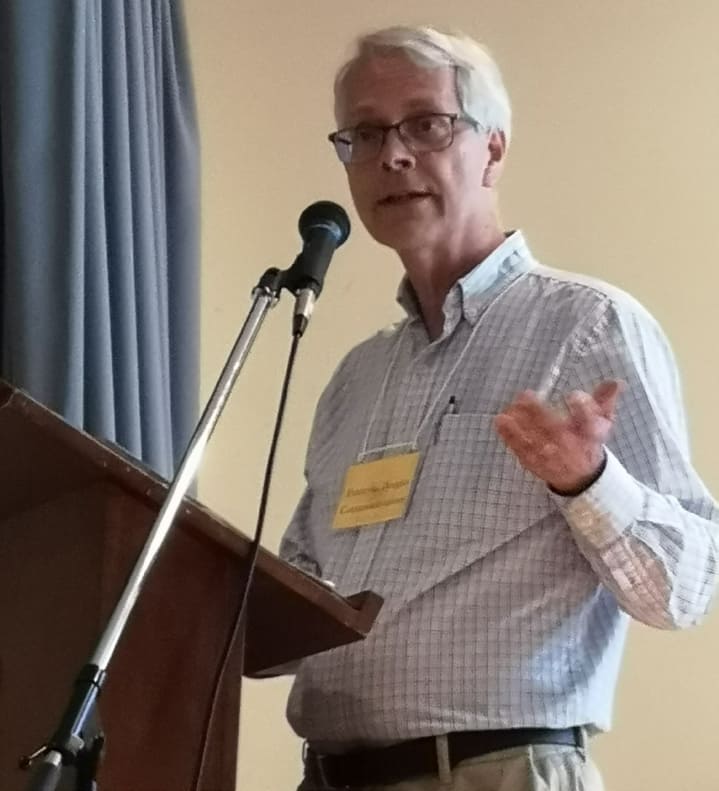 Neighbourhood historian François Bregha, described many prime ministerial homes during his Oct. 9 evening presentation.Sandy Hill is more than just a passing interest for François Bregha. He has lived in Sandy Hill for 34 years. In this time, François has undertaken research on ten prime ministers who have lived in his community, in over a dozen different homes. Many of these homes are still standing, and have become regular stops on François’ community walking tours.
Neighbourhood historian François Bregha, described many prime ministerial homes during his Oct. 9 evening presentation.Sandy Hill is more than just a passing interest for François Bregha. He has lived in Sandy Hill for 34 years. In this time, François has undertaken research on ten prime ministers who have lived in his community, in over a dozen different homes. Many of these homes are still standing, and have become regular stops on François’ community walking tours.
Some of Sandy Hill’s prime ministerial homes are well known, like Stadacona, the Strathcona Apartments and Glensmere. The last of these three was the home of Canada’s eight prime minister, Sir Robert Borden. Built in 1894 for Indian Affairs superintendent Hayter Reed, Borden moved into the home in 1907, giving it the name Glensmere.
After prime minister Borden’s third son, Henry Clifford Borden, moved out in 1941, the home served for 27 years as the Chinese legation, back when the Canadian government considered Taiwan to be “China”. When the much bigger China came to be recognized as the proper “China” in 1972, they established an embassy at the former Our Lady of Charity of the Good Shepherd convent and Glensmere, suddenly empty, was demolished.
Sad, but everyone in attendance for François’ talk at least got a good laugh at the photo he showed of the towering monstrosity that replaced Borden’s elegant abode. Fortunately, Stadacona (Sir John A. Macdonald’s third Sandy Hill home) and the Strathcona Apartments continue to provide architectural dignity on Laurier Avenue East.
Probably the best-known home is Laurier House, built in 1878. Canada’s seventh and tenth prime ministers lived here, although it’s probably less well known that the museum that now honours Sir Wilfrid Laurier and William Lyon Mackenzie King was originally named Kininvie by the home’s first owner, jeweler John Leslie. Leslie named his Sandy Hill home after Kininvie Manor in Banffshire.
This Scottish castle has been in the possession of the Leslie clan since 1521. King renamed the home Laurier House in honour of his mentor, in 1923.
François did some considerable research to dig up information on the many less well-known homes in Sandy Hill. The 13th prime minister, John Diefenbaker not only lived in the Strathcona Apartments, he later rented a small apartment in a house on Wilbrod Street. Our 15th prime minister, Pierre Trudeau, rented an apartment on Besserer Street in the early 1950s, in a home built in 1896 for broker A.M. Sutherland. The home had just been converted to apartments when Trudeau moved in.
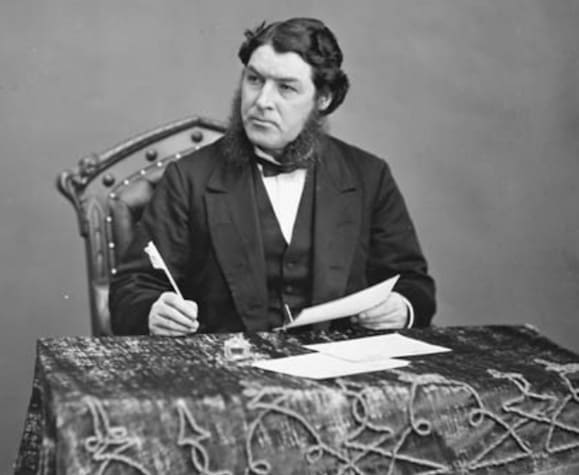 Future prime minister Charles Tupper lived at 274 Daly Ave. in 1872
Future prime minister Charles Tupper lived at 274 Daly Ave. in 1872
Source: Library and Archives CanadaTrudeau’s predecessor, Lester Pearson, seems to have had a particular penchant for Sandy Hill. He lived in three homes in the neighbourhood. Sadly the last of these – the apartment he was living in when he won the Nobel Peace Prize – is slated for demolition. The Ugandan High Commission, which has occupied the building since 1985 has allowed the historic landmark to fall into disrepair.
During the Q&A session with François, special attention was drawn to Canada’s sixth prime minister Sir Charles Tupper who, while on his morning walk to the office at Parliament Hill took a daily diversion to meet up with a lady-friend on Chapel Street. François had hoped to exercise some discretion concerning the affair but was cajoled by the audience to offer some details.
Tupper is unique in having lived in two homes that had also been the home of other prime ministers.
Tupper’s 1872 home at 274 Daly Avenue was converted into apartments in 1982.
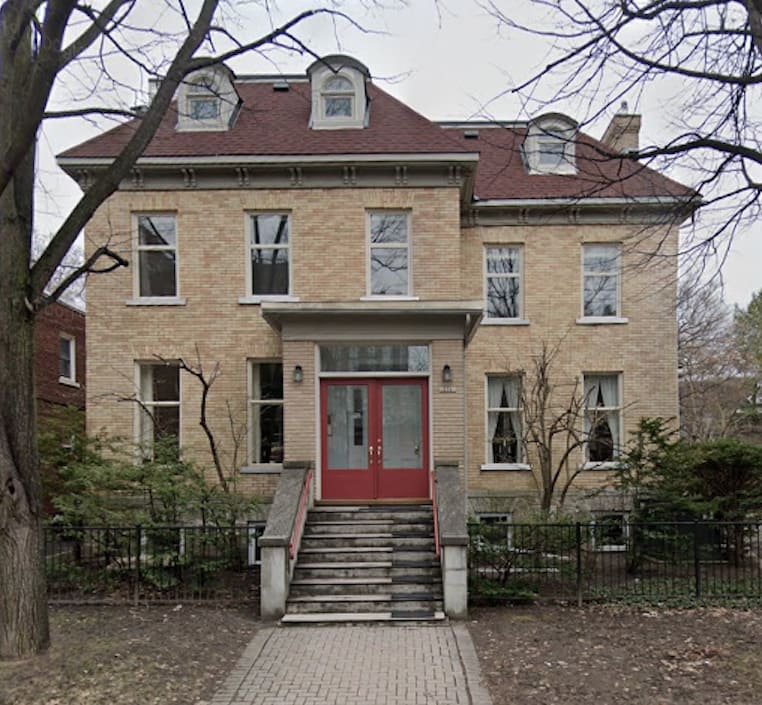 More than a century later, the home was converted into apartments and another future prime minister, Paul Martin, lived there from 1994 to 2003.Paul Martin (our 21st prime minister) lived in one of these units from 1994 until 2003, when he was able to move into 24 Sussex Drive.
More than a century later, the home was converted into apartments and another future prime minister, Paul Martin, lived there from 1994 to 2003.Paul Martin (our 21st prime minister) lived in one of these units from 1994 until 2003, when he was able to move into 24 Sussex Drive.
As for Sir Charles, he later moved to a home named Cliffside, just west of the Parliament Buildings.
This same residence had earlier been the home of Canada’s second prime minister, Alexander Mackenzie. Cliffside was demolished in 1929.
If you’re interested to learn more about Sandy Hill’s many magnificent historic homes, visit the Sandy Hill History website. Here François has more stories, not just of prime ministers, but of business people, war heroes, architects and artists who called Sandy Hill home.
Happy Independence Day?
17 April 1982
There is no definitive moment in history that marks the birth of Canada as an independent nation. Instead, we have a series of dates representing steps along a constitutional continuum from colonial subordination to complete independence. To complicate matters further, Canada became effectively independent decades before the legal papers were signed. Confusingly, none of the dates coincide with Canada Day on 1 July. Canada Day commemorates the passage of the British North America Act (BNA Act), a piece of British legislation that took effect on that date in 1867, giving birth to the Dominion of Canada. The Act, which set out religious and linguistic rights as well as the respective responsibilities of the federal and provincial governments, became Canada’s constitution. One thing it did not do was change Canada’s status within the British Empire.
Notwithstanding the fuzziness over when Canada became independent, there are two strong contenders for a Canadian “independence day.” The first is 11 December 1931, when the Statute of Westminster received Royal Assent in London. The second is 17 April 1982, when Queen Elizabeth assented to the Constitution Act 1982 in Ottawa. While the former date has its merits, I favour the latter.
When the Statute of Westminster became law on 11 December 1931, the British Parliament renounced its right to enact laws for a dominion without the consent of the dominion government, or to overturn dominion legislation that was considered “repugnant” to English law under the Colonial Validity Act of 1865. The Statute was the culmination of work undertaken by Canadian Prime Minister Mackenzie King, in concert with other dominion leaders, especially South Africa’s J.B.M. Hertzog, at the Imperial Conference of 1926. Leaders agreed that the United Kingdom and dominion governments (Canada, Australia, Union of South Africa, New Zealand, Newfoundland, and the Irish Free State) within the British Empire were in no way subordinate to each other in both domestic and foreign affairs, though all were united through a common allegiance to the Crown, and were freely associated members of the British Commonwealth of Nations.
Up until the Statute’s passage, Canada’s governors general were appointed by the British government (or more correctly by the Crown on the advice of the British government) and reported to British authorities. After 11 December 1931, Canada’s governors general were appointed by the Crown on the advice of the Canadian government. As well, diplomatic contacts between the Canadian and British governments were handled by high commissioners who held ambassadorial rank rather than by governors general talking to their British authorities. Canada could also conduct its foreign affairs with other countries without British involvement, though it had already been doing so for some years by convention, signing a bilateral agreement with the United States as early as 1911.
However, whether the Statute of Westminster implied independence is debatable. In 1959, Maurice Allard, the Progressive Conservative MP for Sherbrooke, was sufficiently convinced that he submitted a private member’s bill in the House of Commons to declare 11 December Canada’s Independence Day. Like most private members’ bills, however, his proposal went nowhere.
Back in 1931, the Statute’s passage was largely ignored; there were no independence-day fireworks. The Ottawa Evening Citizen’s brief coverage was sandwiched between a story on an abducted American co-ed and another on four Christmas turkeys left at an Ottawa police station. Toronto’s Globe covered the Statute on page fourteen. While calling it “an admirable piece of legislation,” the newspaper stated, “But let us be honest, who in Canada, barring a few gentlemen suffering from ‘status’ on the brain, worries about the Statute of Westminster?” In another article, the Globe wrote “As far as Canada is concerned, everything remains virtually as it was before the constitutional hair splitting commenced. Canada has governed herself without any interference from any outside source since 1867; She will continue to do so.”
The Globe was partially right. The last time Britain overturned a Canadian law was in 1873 with respect to an act dealing with oaths. But while Canada was effectively independent when it came to domestic matters, it remained subordinate in foreign affairs. Consequently, when Britain declared war on Germany in August 1914, Canada was automatically committed on Britain’s side. Things were different following the passage of the Statute of Westminster. Britain’s declaration of war on Germany in September 1939 did not mean Canada was at war. To stress Canadian independence, Prime Minister Mackenzie King waited a week before joining the Allies. While Canada and Britain had the same monarch, the Crown had effectively been divided. There was now a British Crown and a Canadian Crown, with the same person wearing both “hats.” The divisibility of the Crown subsequently became a generally-accepted constitutional principle throughout the Commonwealth, with the Queen speaking on the advice of her Canadian prime minister when she is in Canada, and on the advice of her Australian prime minister when she is in Australia, etc.
Notwithstanding the Statute of Westminster, legal and constitutional links with Britain remained after 1931 which continued to place Canada in a subordinate position. The Judicial Committee of the Privy Council in London was Canada’s highest appellant Court until 1949 for civil cases. Canada’s Governors General continued to be Britons for another twenty years; the first Canadian appointed to the post, Vincent Massey, didn’t take office until 1952. Most importantly, the Statute explicitly exempted changes to the BNA Act from its purview. In other words, Canadians were unable to make changes to their own constitution without the consent of the British Parliament. This was not a task the British government had insisted on retaining. Rather, the anomalous situation was due to the inability of the federal and provincial governments to agree on a formula to make constitutional amendments. Consequently, Canada’s Parliament remained subordinate to the British Parliament in one vestigial but important way until the BNA Act was finally patriated in early 1982 by the government of Pierre Trudeau.
On 29 March 1982, Queen Elizabeth, wearing her “hat” as Queen of the United Kingdom, assented to the Canada Act 1982, legislation passed by her British Parliament at the request of the Canadian government to patriate the BNA Act to Canada. Three weeks later, on 17 April 1982, as Queen of Canada, she assented in Ottawa to the Constitution Act 1982, legislation passed by her Canadian Parliament. This Act, which includes Canada’s Charter of Rights and Freedoms, and a constitutional amending formula, forms part of Canada’s Constitution. Other key parts of the Constitution include the BNA Act, renamed in Canada as the Constitution Act 1867, and subsequent amendments.
The decision to patriate the Constitution was highly controversial. Two years earlier, with the failure of a separatist referendum in Quebec on “sovereignty association,” Prime Minister Trudeau had promised constitutional renewal to Quebec. But despite lengthy negotiations, a federal-provincial consensus could not be reached. A major sticking point was the proposed charter of rights and freedoms which many provinces feared would transfer powers from legislatures to the courts. Only Ontario and New Brunswick supported Trudeau. The others, known as the Gang of Eight, which included Quebec, held out. Following last ditch talks in Ottawa in November 1981, and threats by Trudeau to patriate the Constitution without provincial support, a position that the Supreme Court ruled as being legal though not desirable, the Gang of Eight collapsed. In what later became known as the “Night of Long Knives,” a late-night agreement was reached in Ottawa among the leaders of the federal government and nine provinces after Levesque had left the negotiations to go to bed. In his memoirs, Levesque said that “he had been stabbed in the back by a bunch of carpetbaggers.”
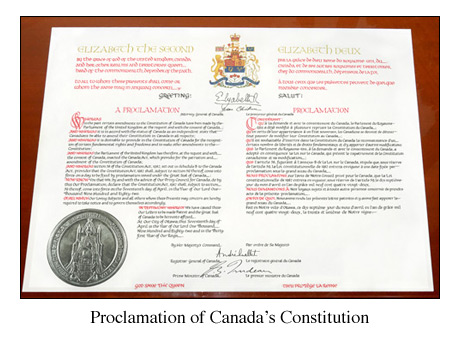 17 April 1982 was a drab, rainy day in Ottawa when Queen Elizabeth appended her signature to the Constitution Act on an outdoor dais setup on Parliament Hill. The proclamation document was also signed by Prime Minister Trudeau, André Ouellet, in his capacity as the Registrar-General, and Justice Minister Jean Chrétien. 32,000 spectators watched the historic occasion, undaunted by torrential rain showers. People started to show up on the Hill as early as 5.30am, five hours before the scheduled event. But the event was clouded by more than just the weather. Quebec, under the separatist Parti Quebecois government of René Levesque, boycotted the event. Instead, Levesque led a demonstration in Montreal against the new Constitution attended by 20,000 people. With considerable hyperbole, the demonstrators called Quebec’s Liberal MPs who supported the new Constitution “traitors,” and the Constitution, a “charter of genocide.”
17 April 1982 was a drab, rainy day in Ottawa when Queen Elizabeth appended her signature to the Constitution Act on an outdoor dais setup on Parliament Hill. The proclamation document was also signed by Prime Minister Trudeau, André Ouellet, in his capacity as the Registrar-General, and Justice Minister Jean Chrétien. 32,000 spectators watched the historic occasion, undaunted by torrential rain showers. People started to show up on the Hill as early as 5.30am, five hours before the scheduled event. But the event was clouded by more than just the weather. Quebec, under the separatist Parti Quebecois government of René Levesque, boycotted the event. Instead, Levesque led a demonstration in Montreal against the new Constitution attended by 20,000 people. With considerable hyperbole, the demonstrators called Quebec’s Liberal MPs who supported the new Constitution “traitors,” and the Constitution, a “charter of genocide.”
Trudeau made reference to Quebec’s absence at the patriation ceremony on Parliament Hill. Speaking to the “silent majority” in Quebec, he remarked that the Charter and the amending formula which allows Quebec to opt out of any constitutional change that might touch on language and culture with full financial compensation, did not sacrifice anything “essential to the originality of Quebec.” For her part, Queen Elizabeth, speaking in French, expressed sorrow for Quebec’s refusal to participate in the proclamation of Canada’s new Constitution. She ended her remarks saying “Today, I have proclaimed the new Constitution – one that is truly Canadian at last. There could be no better moment for me, as Queen of Canada, to declare again my unbounded confidence in the future of this wonderful country.”
In the years that followed, attempts were made by the federal government under Brian Mulroney to find a formula acceptable to Quebec. With the failure of both the Meech Lake and Charlottetown Accords in the late 1980s and early 1990s, the constitutional issue was put on the back burner, the nation fatigued by its constitutional problems. The Province of Quebec has still not endorsed the Constitution Act.
Sources:
CBC, 2001, “The Knight of Long Knives,”.
Edinger, Elizabeth, 2011-12. Casebook, Law 100, Canadian Constitutional Law, University of British Columbia, http://faculty.law.ubc.ca.
Department of Justice, 2013. The Constitution Acts 1867 to 1982.
Heard, Andrew, 1990. Canadian Independence.
Hilmer, Norman, 2013. “Patriation: The Constitution Comes Home,” Historica Canada.
Senate of Canada, 2014. The Constitution Table, Royal Proclamation on Parliament Hill.
The Globe, 1931. “Constitutional Safeguards,” 9 April.
———————, 1931. “Score for the First Week,” 16 November.
———————, 1931. “Westminster Bill Goes to Committee in British House,” 21 November.
———————, 1931. “Finis to Status,” 5 December.
——————–, 1931. “Westminster Bill Given Final Assent,” 11 December.
The Ottawa Citizen, 1982. “The nation’s coming of age was a day made for children,” 19 April.
———————-, 1982. “Queen offers Quebec praise for its cultural contribution,” 19 April.
———————-, 1982. “Ceremonies leave PM in a Whirl,” 19 April.
———————-, 1982. “PQ renews drive for separation,” 19 April.
———————-, 1982. “Queen Elizabeth: ‘I have seen a vision of this country take shape,’” 19 April.
———————-, 1982. “PM: Constitution a fresh beginning,” 19 April.
The Ottawa Evening Citizen, 1931. “Westminster Statute Given Royal Assent,” 11 December.
The National Archives (UK), 2014. Statute of Westminster 1931.
Images: Queen Elizabeth signing Proclamation of Constitution Act, 17 April 1982.
Proclamation of Constitution Act, Government of Canada.
Retired from the Bank of Canada, James is the author or co-author of three books dealing with some aspect of Canadian history. These comprise: A History of the Canadian Dollar, 2005, Bank of Canada, The Bank of Canada of James Elliott Coyne: Challenges, Confrontation and Change,” 2009, Queen’s University Press, and with Jill Moxley, Faking It! A History of Counterfeiting in Canada, 2013, General Store Publishing House, Renfrew, Ontario. James is a Director of The Historical Society of Ottawa.



